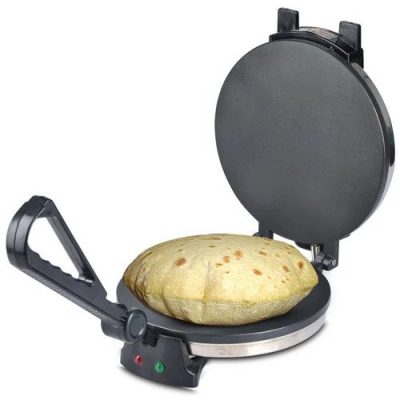Project Report For Roti Maker Machine
Introduction
Project Report For Roti Maker Machine is as follows.
A roti making machine is a completely or semi-automatic device used to create rotis, puris, and parathas. Most electrically powered machines have a body that is shockproof. These are best suited for people who want to enjoy the dish without having to put in a lot of effort in the kitchen and who are unsure how to create rotis. These are perfect for catering outdoor events like small parties at restaurants, hotels, and other venues. Due to labour and fuel cost advantages, roti-making machines are a practical and effective alternative to traditional methods.
The wheat flour dough is prepared and constantly pumped to the extruder using a planetary mixer. The dough sheet is moved to the endless belt conveyor by a fish tail die. The sheet is cut uniformly into a circle as it moves along the conveyor and through the rotary cutter.
The remaining/cut pieces of the sheet are now captured and sent back to the extruder as the circular chapatis enter the baking chamber. LPG serves as the heat source for baking. There is a three-tiered infinite conveyor system in the baking chamber. The first and second conveyors have slats made of carbon steel. At the bottom, ribbon burners heat these. The chapatis are subjected to direct flame in the third stage to produce a puffed product.

Types Of Roti Maker Machine
- Manually Operated Roti Makers :- We might find out how many manually operated Roti makers are available for purchase both online and off-line by looking up roti or chapati makers. When using them, the dough is kneaded to create extra-soft dough balls before being used to make rotis. These are compressed into tiny discs and placed in the space between the heated pan and cover of the device, which puffs as it quickly reaches the ideal temperature.
- Semi-Automatic or Fully Automatic Roti Makers :- Roti makers come in semi-automatic and completely automated varieties. Some of them need human supervision and participation, ranging from light to moderate. However, the size and capacity of these automatic or semi-automatic roti makers are enormous. They produce 600–900 rotis each hour, making them perfect for restaurants. They are made to work in locations where rotis must be produced in big quantities. As a result, these roti makers would not fit in a typical kitchen because they are enormous and maybe too expensive for the intended use.
Project Report Sample On
Roti Maker Machine
Get Completely Custom Bankable Project Report
Market Potential Of Roti Maker Machine
The market for roti makers is expected to increase by USD 34.82 million at a CAGR of 4.29% between 2021 and 2026.
During the anticipated period, the market will experience the highest level of demand from commercial end-users for roti marketplaces. The segment is fueled by a rising global geriatric population, an increase in the desire for locally produced, fiber-rich food items like roti and chapati, and the ease of mass producing roti by hiring roti makers. The spread of modern kitchen gadgets like roti makers throughout the commercial sector would further promote the segment’s growth.
The global roti making machine market is expanding as a result of the food industry’s increased preference for automation. Machines that make rotis are widely used in the food processing industry. The market for roti making machines worldwide was dominated by the commercial application segment. The personnel who prepare the meals in various departments of institutes, langars, hospitals, schools and college dormitories, industrial canteens, and railway and defence establishments benefit greatly from the use of roti making machines.
Additionally, roti makers make chapatis that resemble those made at home in the cleanest possible manner. The device claims to produce rotis at a rapid rate with the best roasting or cooking and the least amount of upkeep. All of these factors increase the demand for roti making machines.

